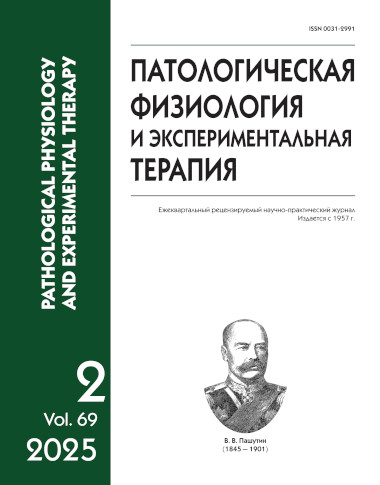Prognostic markers for the course of brucellosis infection
Abstract
Introduction. Studies have shown that hemostatic disorders in brucellosis develop due to the systemic nature of the infection and lead to endothelial dysfunction. The state of the hemostatic system in brucellosis infection remains virtually unstudied, which warrants further research. Identification of diagnostic markers can help assess the prognosis of the disease and early detection of the risk for developing vascular complications.
The aim of the study was to determine markers of the anticoagulant hemostatic system and the importance of vascular endothelial factor in assessing the prognosis of brucellosis.
Methods. The study included patients diagnosed with acute brucellosis (n = 78) who were admitted to the Brucellosis Department of Stavropol and the hospital for infectious diseases of the Republic of Dagestan. The study material was blood serum/plasma from patients with acute brucellosis. The control group consisted of 34 individuals who had not had brucellosis and were not vaccinated against this infection. The plasma concentration of antithrombin III was measured by the chromogenic method; the concentration of protein C was determined photometrically; the concentration of fibrinogen was measured using an automatic analyzer; soluble fibrin-monomer complexes (SFMC) were assessed by the orthophenanthroline test; and the concentration of vascular endothelial growth factor (VEGF) was determined by the enzyme-linked immunosorbent assay (ELISA).
Results. In the acute phase of the disease, patients with brucellosis had decreases in the plasma concentrations of primary anticoagulants (antithrombin III, protein C), an increase in fibrinogen, and, as a consequence, an increase in the concentration of the secondary anticoagulant (SFMC) relative to the control group. The concentration of the endothelial marker, vascular endothelial factor, was increased.
Conclusion. Long-term persistence of brucellosis leads to a rather lengthy, but not pronounced inflammation that results in the development of a protective adaptive reaction aimed at maintaining the hemostatic system. The studied indicators (antithrombin III, protein C, fibrinogen, SFMC, VEGF) are diagnostically significant in assessing the prognosis of the course of brucellosis infection.Introduction.
Downloads
References
1. Chourmouzi D., Boulogianni G., Kalomenopoulo M., Kanellos I., Drevelegas A. Brucella liver abscess; imaging approach, differential diagnosis, and therapeutic management: a case report // Cases Journal. 2009. 2:7143. doi: 10.4076/1757-1626-2-7143.
2. Reshetnyak V.I., Maev I.V., Reshetnyak T.M., Zhuravel S.V., Pisarev V.M. Liver diseases and hemostasis (review). Part I. Non-cholestatic liver diseases and hemostasis // General Reanimatology. 2019.15:5. Р. 74-87. doi:10.15360/1813-9779-2019-5-74-87. (in Russian)
3. Gordeeva O.B., Dobrotok A.V., Andreeva I.V., Dovgan E.V., Egorova O.A., Kargin V.S. The problem of deficiency of anticoagulant factors. Clinical example // Lechashchij vrach. 2023. 26(12):57-62. doi: 10.51793/OS.2023.26.12.008. (in Russian)
4. Makatsaria A.D., Serov V.N., Sukontseva T.A., Bitsadze V.O., Shkoda A.S., Khizroeva D.Kh. et al. Pathogenesis of coagulopathy in septic shock // Akusherstvo i ginekologiya. 2019. 10:13-19. doi: 10.18565/aig.2019.10.13-21. (in Russian)
5. Khizroeva D.Kh., Mikhailidi I.A., Stuleva N.S. Importance of protein C determination in obstetric practice // Рrakticheskaya medicina. 2013. 7(76):52-57. (in Russian)
6. Mikhailichenko V. Yu. The role of VEGF in angiogenesis in norm and pathology / // Novoobrazovanie. 2010. 1 (5): 174-181. (in Russian)
7. Levi M., T. van der Poll, Buller H.R. Bidirectional relation between inflammation and coagulation // Circulation. 2004. 109(22):2698-704. doi: 10.1161/01.CIR.0000131660.51520.9A.
8. Redkin I. V., Lopatin A. F., Skripkin Yu. V., Samoylenko V. V., Likhvantsev V. V. Determination of the level of antithrombin allows predicting clinical outcomes of sepsis // Vestnik anesteziologii i reanimatologii. 2018. 15 (3): 41-46. doi: 10.21292/2078-5658-2018-15-3-41-46. (in Russian)
9. Mosnier L.O., Griffin J.H. Protein С anticoagulant activity in relation to anti-inflammatory and antiapoptotic activities // Front. Biosci. 2006. 11: 2381-99. doi: 10.2741/1977.






